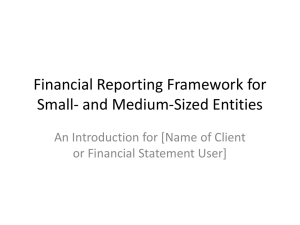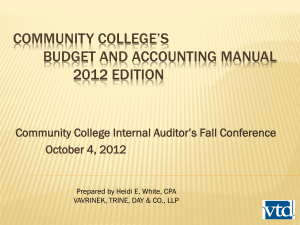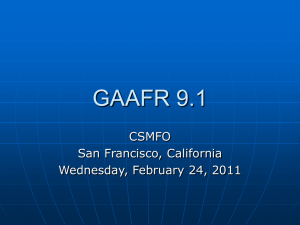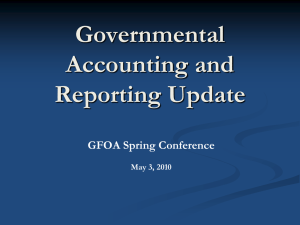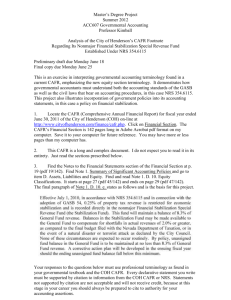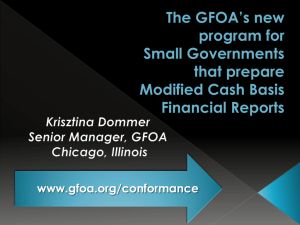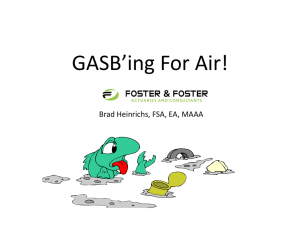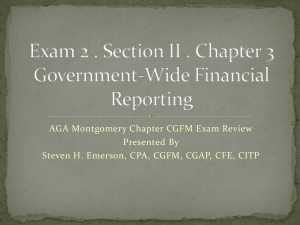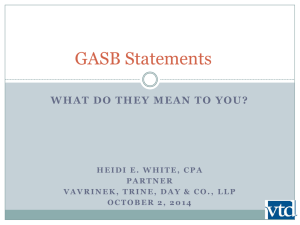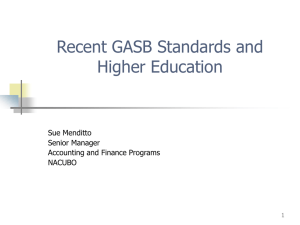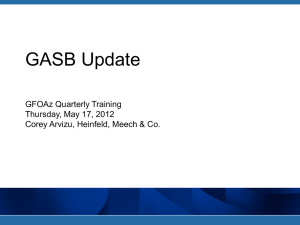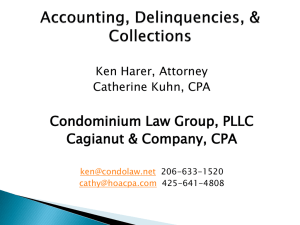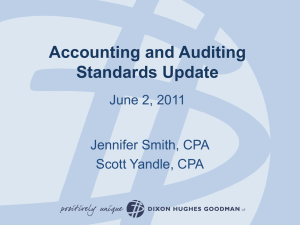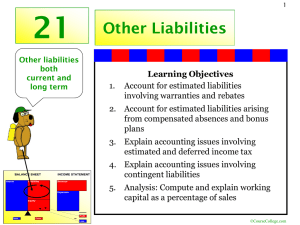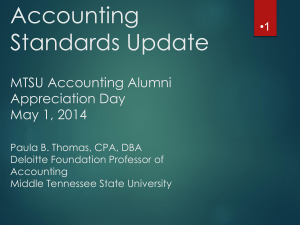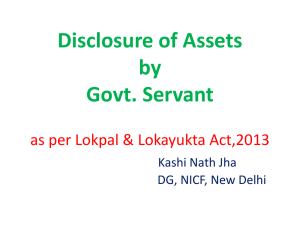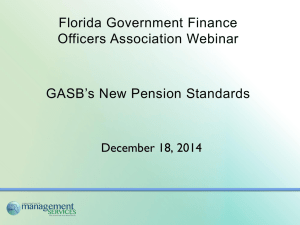An Introduction to GAAP Financial Reporting
advertisement
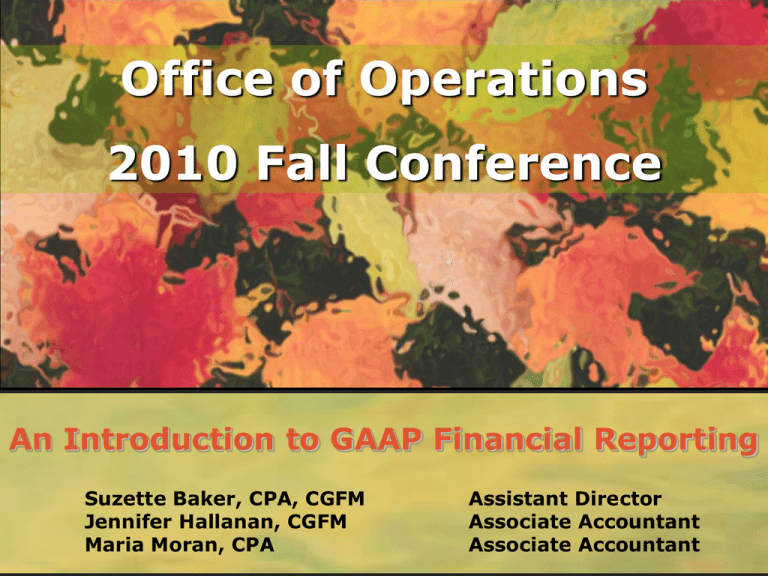
Office of Operations 2010 Fall Conference An Introduction to GAAP Financial Reporting Suzette Baker, CPA, CGFM Jennifer Hallanan, CGFM Maria Moran, CPA Assistant Director Associate Accountant Associate Accountant Overview General Background State’s GAAP Financial Statements Agency Financial Reporting Package State’s Financial Condition Current GASB Statements Summary/Questions/Comments General Background Financial Reporting Comprehensive Annual Financial Report Financial Condition Report Interim GAAP Financial Statements Chapter 551 Functional Reporting Five Year Comparative Financial Statements Schedule of Expenditures of Federal Awards Citizens’ Guide and Citizen-Centric Report Certification of Tax Revenues LGAC & Oil Spill Fund Financial Statements Implementation of GASB Standards Financial Reports General Background What is GAAP Financial Reporting and why is it important? Generally Accepted Accounting Principles (GAAP) Chapter 405 of the Laws of 1981 Report to Legislature MUST be completed by July 29th Accounting Basis Cash Basis Reporting (pre-1982) Modified Accrual (Fund Accounting) Full Accrual (GASB 34) Definitions GAAP - Generally Accepted Accounting Principles GASB - Governmental Accounting Standards Board CAFR - Comprehensive Annual Financial Report-defined format FCR - Financial Condition Report “Financial Position” vs. “Financial Condition” Definitions (continued) GFOA - Government Finance Officers Association Certificate of Achievement for Excellence in Financial Reporting AFRP - Agency Financial Reporting Package CAFR Comprehensive Annual Financial Report CAFR Statistics for 2010 CAFR $201 billion in entries 171 entries 6,825 entry lines CAFR Three Major Sections: 1. Introductory 2. Financial 3. Statistical CAFR Introductory Section 1. Comptroller’s Letter 2. Financial Overview 3. Certificate of Achievement 4. Organization Chart and State Officials CAFR Financial Section 1. Management’s Discussion and Analysis 2. Basic Financial Statements Entity-wide financial statements Governmental Funds Enterprise Funds Fiduciary Funds Discretely Presented Component Units Note Disclosures CAFR Financial Section (continued) 3. Required Supplementary Information (RSI) 4. Other Supplementary Information Financial Statements by Fund Non-Major Discretely Presented Component Units CAFR Statistical Section 1. Demographic 2. Economic 3. Miscellaneous 4. Ten year presentation, when available Agency Financial Reporting Package On-Line System Agency Financial Reporting Package Gathers information outside of the Central Accounting System (CAS) Collects information from approximately 215 State agencies Used for annual and interim reporting Agency Financial Reporting Package Gross Accounts Receivable Receivables exist when revenues are owed to the State, but cash is not received and recorded in CAS before March 31st Classified as current and long-term receivables Approximately 50 agencies and $815 million Details reported in Note 4 Agency Financial Reporting Package Gross Accounts Receivable Agency Financial Reporting Package Gross Accounts Receivable Agency Financial Reporting Package Gross Miscellaneous Accrued Liabilities Outstanding liabilities are moneys owed by the State at year end, and not entered into CAS by May 31st with a liability date of March 31st or earlier Classified as current and long-term liabilities Approximately 22 agencies and $54 million Details reported in Note 8 Agency Financial Reporting Package Gross Miscellaneous Accrued Liabilities Agency Financial Reporting Package Gross Miscellaneous Accrued Liabilities Agency Financial Reporting Package Compensated Absences Reports the liability owed by the State for employees’ accumulated annual leave Over 4,000 employees and approximately $2.1 billion Reported in accrued liabilities on the Statement of Net Assets Details reported in Note 1j Agency Financial Reporting Package Local Assistance Liabilities Local Assistance liabilities exist when the required services have been provided or contractual requirements have been met by an agency or the State Reported when the liability is not entered into CAS by May 31st Details reported in Note 8 Agency Financial Reporting Package Local Assistance Liabilities Agency Financial Reporting Package Local Assistance Liabilities Agency Financial Reporting Package Contingencies Represents a condition, situation or circumstance involving a possible loss Examples are: audit disallowance, adverse litigation, claims or assessments Agency Financial Reporting Package Contingencies (continued) Information is compared to open cases with the Attorney General’s Office Details reported in Notes 10 or 11 State’s Financial Condition Financial Condition Report Provides citizens with an overview of the financial condition of the State Illustrates the future trends in the State Discusses the State’s ability to meet current and future financial and service obligations General Fund Change in Fund Balance Cash vs. GAAP Reporting (amounts in millions of dollars) YEAR 2010 2009 2008 2007 2006 CASH 353 (805) (291) (212) 711 GAAP (594) (6,895) 1,567 202 1,636 Total Receipts Total State Receipts (amounts in billions) *Estimated ** Projected Total Spending (amounts in billions) ** Projected Total Spending Federal Stimulus National vs. New York (amounts in millions) Federal Stimulus Life-to-Date Disbursements (amounts in millions) * Information as of Fiscal Year Ended March 31, 2010 Public Health (amounts in billions) Public Welfare (amounts in thousands) Education (amounts in billions) Local Government Local Government Capital (amounts in billions) Debt (amounts in billions) Debt (amounts in billions) Economic and Demographic Trends (amounts in billions) Economic and Demographic Trends (amounts in billions) All Government Funds Projected Growth (amounts in billions) Current GASB Statements GASB 51- Accounting and Financial Reporting for Intangible Assets Intangible assets lack physical substance, are non-financial, and have useful lives beyond a single reporting period Examples: patents, copyrights, permits, trademarks, software and timber and mineral rights Accounting Bulletin – A-614 Implementation for fiscal year 4/1/103/31/11 Current GASB Statements GASB 54- Fund Balance Reporting and Governmental Fund Type Definitions Changes how fund balance is presented Clarifies use of governmental fund types Ex. Special Revenue funds may have limits on their use Implementation for fiscal year ended 3/31/12 Summary Financial Reporting is required to: Recognize the true financial position and condition of the State, and reports the condition to the taxpayers GAAP financial statements present timely modified accrual and full accrual-based financial statements to the public, bond rating agencies, investment banks, etc Enable comparability with other states and over a period of time Questions/Comments? Suzette Baker (518) 486-1234 sbaker@osc.state.ny.us Jennifer Hallanan (518) 486-3048 jhallanan@osc.state.ny.us Maria Moran (518) 474-3691 mmoran@osc.state.ny.us
